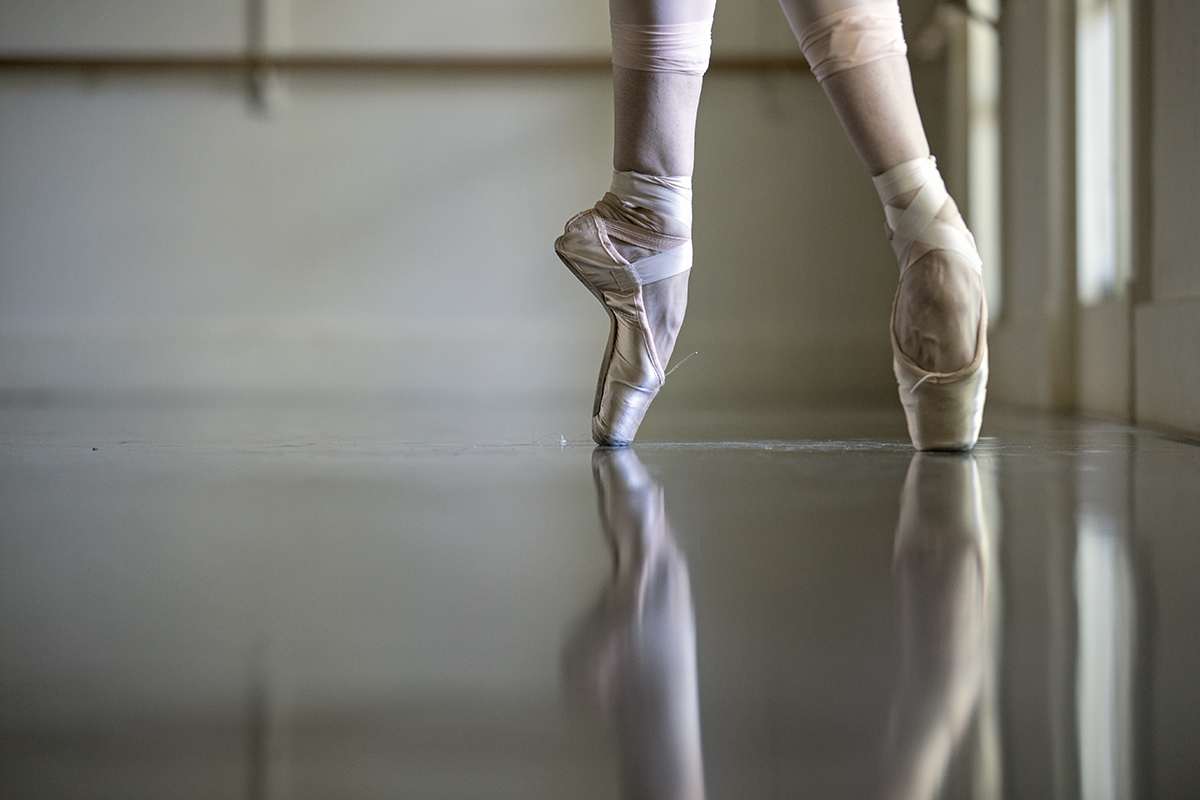She’s probably gone through hundreds by now, but Sarah Lapointe remembers her first pair of pointe shoes.
She was 11 years old and standing in front of a mirror in a dance supply shop, surrounded by her friends from class. Holding onto a ballet barre, she went up and down on her toes, with the pristine satin slippers gripping her feet as she admired her reflection.
Before that moment, being en pointe seemed like it was only a dream.
Going en pointe for the first time is a significant moment for a dancer — an elevation that requires maturity, strength and extensive practice to find beauty on top of the toes.
“It is just being part of a tradition,” said Jean-Pierre Bonnefoux, artistic director of Chautauqua Dance. “The look is beautiful. It’s like having high heels.”
Putting on the shoes can be considered a rite of passage for a young dancer.
“It made you feel like a real ballerina,” said Charlotte Ballet dancer Amelia Sturt-Dilley. “You were a real ballet dancer when you put on pointe shoes.”
The Shoes
Pointe shoes are a type of dance footwear with a flat toe (called a platform) to allow dancers to stand, turn and execute skills in a different way than in soft shoes or bare feet.
Patricia McBride, master teacher and repetiteur at Chautauqua Dance, was a prima ballerina for the New York City Ballet. With her experience as a muse for George Balanchine (the famous choreographer known for his quick and flowery style), she said being en pointe creates a completely different look for a dancer.
The shoes are made by hand, and when dancers get a job in a company, they can have shoes made to their exact specifications, McBride said, as she was able to do when she joined the New York City Ballet. But that still may not do the job.
“Every pair is a little bit different,” Sturt-Dilley said. “They’re all handmade so it’s impossible to make them all the same.”
Each shoe has a maker, or the person who put the shoe together, McBride said.
“It’s a lost art now,” McBride said. “We’re having trouble with finding the shoes because there aren’t a lot of young people who like to sit around and make toe shoes anymore. It was such a tradition.”
The shoe (specifically the part around the toes) is made out of layers of burlap, felt, glue and surrounded by satin. It has several parts, according to “Pointe Shoe Anatomy” by Gaynor Minden, a pointe shoe brand, such as:
• The platform: the flat tip of the shoe
• The box: hard casing around the toes
• The vamp: what covers the top of the toes and feet
• The shank: stiff insole of the shoe
The shoes also have elastic straps and ribbons that not only keep the shoe on the foot, but support the ankle as well. When dancers are en pointe, their Achilles tendon is basically at a 90-degree angle and the ribbons compress the tendon, according to Jeffrey A. Russell in a 2012 article in the Lower Extremity Review. Too tight and incorrectly tied ribbons can hurt and strain the Achilles tendon. Tendonitis is a common injury amongst dancers.
Each dancer sews her ribbons and elastics — some even do it with dental floss. Sturt-Dilley said most people are “absolutely fascinated that the ribbons and elastics don’t come on the shoes.”
A pair of shoes, Lapointe said, can cost anywhere from about $100 to $150, and depending on certain factors — the type of dance, the amount of pressure on the shoe, heat and sweat — a pair of shoes could last only one act of a ballet.
“Back in Charlotte, I can hold a pair for two weeks, maybe,” Lapointe said. “But here, I went through a pair in a class. They’re just so dead.”
When a pair is “dead,” it loses all the structure and support needed. Sturt-Dilley said the environment can take a toll on the toes.
“And with this weather — I had a brand-new pair today and they’re about dead because it’s humid and your shoe is glue,” Sturt-Dilley said. “I mean, it’s gone.”
That means that in one week of rehearsals, a dancer could go through several pairs of shoes, or several hundreds of dollars. Sturt-Dilley and Lapointe said their shoes are provided by Charlotte Ballet.
Sarah Finnegan, Ashlan Zay and Clare Merante are all Festival dancers in the School of Dance. They’ve had to come prepared for a summer of dancing at Chautauqua. The three said they use glue or wood-hardener to help the shoes last longer.
“I brought six, but I’m having my mom send me four more,” Finnegan said.
The Prep
Along with sewing the elastics and ribbons, some dancers will take extra steps to get the perfect fit.
“I sew them first and when I get into the studio, I put water on my bunions because my shoes are too hard, so I put water there so it forms to my bunions so its not rubbing against it,” Lapointe said. “Then, I’ll bend the shank. … I stand on the tips and flatten them.”
Some people will reglue their shoes, rip the top piece of the shank out (also known as three-quartering it), sew the sides of the fabric so it fits better, or break the box with a door. It’s up to the dancer.
“I’m still trying to find the right shoe that fits the way I like it,” Lapointe said. “I’m still experimenting.”
Simply slipping on the shoes isn’t the only step in preparation, and even the smallest break in a schedule can cause difficulties.
“I can go the whole season and I can be fine because I’ve worked up the callouses and the bruises and everything to do it,” Lapointe said. “But then when I have even a week off and then I have to put pointe shoes back on, I have to regain that strength and the callouses.”
The Pain
As far as the pain goes, there’s one thing to keep in mind: dancers are on top of their toes, anywhere from an hour to eight hours a day (or more).
“The first couple days is awful,” Sturt-Dilley said. “Our first week working, my bed sheets couldn’t even be on my toenails. A breeze would hit them [and it would be painful]. It hurt so bad.”
Ibuprofen, ice baths and putting Orajel — yes, the tooth-numbing medication — on toes or open skin are all ways dancers can help relieve the pain, Lapointe said.
“We do a lot of ice baths for our feet,” Finnegan said. “Normally now, I don’t feel as much pain unless I’ve been in the shoes for hours.”
Lapointe said she uses spacers, or padding that can be put in between the toes to make sure they don’t rub together.
Heather Duncan, a Festival dancer, preps her feet for rehearsal using a spacer, friction block and wrapping her toes with paper towels. Finnegan uses duct tape on her toes before slipping them into a toe pad, which is a cushion used just on the toes between the skin and the shoe.
“My studio was a very purist studio and didn’t allow us to wear toe pads,” Finnegan said about starting en pointe. “I did my first class en pointe [without toe pads] and literally thought I was dying.”
Merante said she already knows exactly where blisters will form, so she’s using tape to try and prevent pain.
Depending on the type of ballet or the moves within it, the different muscles in the feet are worked out and a different strength of shoe is needed.
“Four weeks into the season, your feet are huge,” Sturt-Dilley said. “You can’t even fit them into the shoe. There’s so many variables and elements that can affect them.”
Finnegan said using shoes a size bigger can help after long hours in the studio that can cause the feet to swell.
The Performance
Though it might take a lot of prior thought to prepare a pair, Sturt-Dilley and Lapointe said it’s just important that their shoes aren’t what they’re thinking about during a performance.
“I think it’s all about being comfortable, not in terms of no pain,” Sturt-Dilley said. “Dance is so hard already that if you’re having to worry about a shoe, or if a shoe is pulling you from one side of your foot to the other, it’s really … frustrating.”
Merante said pointe shoes bring out a different aspect in her dancing, compared to soft shoes or bare feet.
“I feel like I can perform more in pointe shoes because I feel like I’m not practicing anything,” Merante said. “I feel like I’m dancing.”
Bonnefoux said there needs be an understanding of pointe with young choreographers. It can be difficult for male choreographers, considering they have not performed en pointe. He said it’s good more women are becoming choreographers.
Although Bonnefoux is surprised the tradition has stuck, the future of pointe will depend on those who can create.
“It will depend on the quality of the choreographers,” Bonnefoux said. “It will depend on the invention and how innovative they are going to be with it.”
Even with the headache, Sturt-Dilley and Lapointe agreed the lines created with the body, easy turning and just the look of being en pointe make it all worth it in the end. And although they would love it if everyone knew how hard it was, that can mess with the overall illusion that it’s supposed to look easy.
But in the meantime, although some will never see the blood or callouses, the dancers will still be experimenting with what makes the perfect shoe.
“I don’t think the perfect pair exists,” Sturt-Dilley said. “It’s like a magical fairy tale. … Yesterday I thought my shoes were awesome and today I hated them. It was the same shoe. I’m the same person. … You never know. And you have to learn how to make it work. It’s exhausting.”
To which Lapointe added: “Until you get a new pair.”





